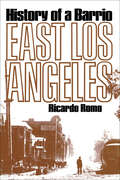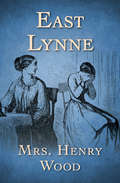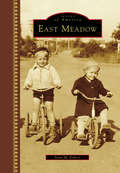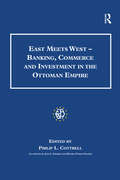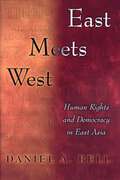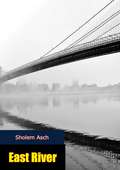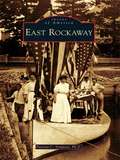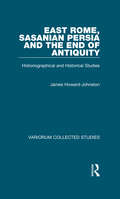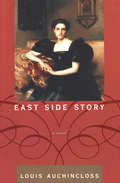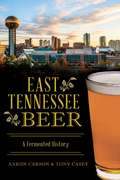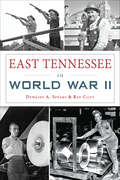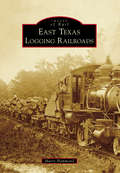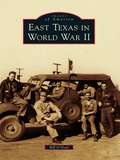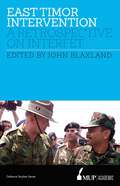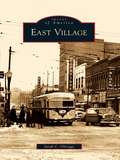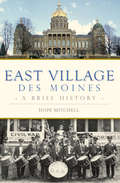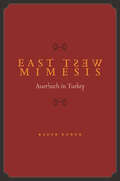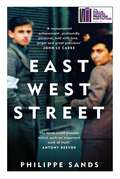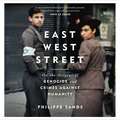- Table View
- List View
East Los Angeles: History of a Barrio
by Ricardo RomoThis is the story of the largest Mexican-American community in the United States, the city within a city known as "East Los Angeles." How did this barrio of over one million men and women—occupying an area greater than Manhattan or Washington D.C.—come to be? Although promoted early in this century as a workers' paradise, Los Angeles fared poorly in attracting European immigrants and American blue-collar workers. Wages were low, and these workers were understandably reluctant to come to a city which was also troubled by labor strife. Mexicans made up the difference, arriving in the city in massive numbers. Who these Mexicans were and the conditions that caused them to leave their own country are revealed in East Los Angeles. The author examines how they adjusted to life in one of the fastest-growing cities in the United States, how they fared in this country's labor market, and the problems of segregation and prejudice they confronted.
East Lothian Folk Tales
by Tim Porteus Donald Smith Mags MacFarlaneStoryteller Tim Porteus brings together stories from the rugged coastlines, golden beaches, rolling countryside and dramatic Lammermuir Hills of the ancient county of East Lothian. In this treasure trove of tales you will meet Scottish Kings and Queens, saints and sinners, witches and wizards, ghosts and giants, fools and tricksters - all as fantastical and powerful as the landscape they inhabit. Retold in an engaging style, and richly illustrated with unique line drawings, these humorous, clever and enchanting folk tales are sure to be enjoyed and shared time and again.
East Lynne: Or The Earl's Daughter
by Mrs. Henry WoodA married aristocratic woman succumbs to desire in this nineteenth-century English novel. Lady Isabel Vane married for all the wrong reasons—only to one day find her lawyer husband neglecting her for another woman. Seething with jealousy, she leaves behind her husband and their child for the flirtatious Francis Levison. It&’s a risk she takes willingly, but it comes with a heavy price that will lead her to the depths of despair and a quest for redemption. A classic page-turner from the &“sensation novel&” trend in England, East Lynne plays upon the Victorian fears of infidelity, promiscuity, and divorce. A tale of disaster, disguise, and adultery, it continues to surprise readers today.
East Meadow (Images of America)
by Scott M. EckersFollowing World War II, East Meadow developed into a suburban paradise some 20 miles east of New York City. The hamlet's name was derived from its proximity to the colonial settlement at Hempstead and the topography of the Hempstead Plains that covered much of present-day Nassau County. East Meadow was once known for herding sheep, raising cattle, and growing potatoes--livestock frequently outnumbered the human population. Large farming estates of the Barnum, Carman-Lowden, and Fish families drove the local economy and existed alongside smaller farms and businesses that dotted the colonial-era roads. East Meadow was also home to high-society Gilded Age mansions, dangerous automobile races, stylish polo and golf clubs, and famous residents such as Eleanor Roosevelt, Joseph J. Lannin, and Alva Vanderbilt Belmont. Proximity to Mitchel Air Force Base and Roosevelt Field placed East Meadow directly under the path of important airplane firsts, such as Charles A. Lindbergh's 1927 transatlantic flight.
East Meets West - Banking, Commerce and Investment in the Ottoman Empire (Studies in Banking and Financial History)
by Monica Pohle FraserBringing together cultural, economic and social historians from across Europe and beyond, this volume offers a consideration from a number of perspectives of the principal forces that further integrated the Ottoman Empire and Western Europe during the first century of industrialisation. The essays not only review and analyse the commercial, financial and monetary factors, negative as well as positive, that bore upon the region's initial stages of modern transformation, but also provide a ready introduction to major aspects of the economy and society of the Ottoman Empire in the nineteenth century. Beginning with two chapters providing the context to the development of Ottoman relations with Western Europe up to the second half of the nineteenth century, the collection then moves on to explore more specific questions of trade links, the impact of improved transportation and communications, the development and changing nature of Ottoman finance and banking, as well as European investment in Turkey. The outcome is a broad ranging consideration of how all these issues played a fundamental role in the final decades of the Ottoman Empire and the emergence of Turkey as a modern state with links to both east and west. The essays in this collection derive from the EABFH colloquium held in the Imperial Mint, Istanbul, in October 1999.
East Meets West: Human Rights and Democracy in East Asia
by Daniel A. BellIs liberal democracy a universal ideal? Proponents of "Asian values" argue that it is a distinctive product of the Western experience and that Western powers shouldn't try to push human rights and democracy onto Asian states. Liberal democrats in the West typically counter by questioning the motives of Asian critics, arguing that Asian leaders are merely trying to rationalize human-rights violations and authoritarian rule. In this book--written as a dialogue between an American democrat named Demo and three East Asian critics--Daniel A. Bell attempts to chart a middle ground between the extremes of the international debate on human rights and democracy. Bell criticizes the use of "Asian values" to justify oppression, but also draws on East Asian cultural traditions and contributions by contemporary intellectuals in East Asia to identify some powerful challenges to Western-style liberal democracy. In the first part of the book, Bell makes use of colorful stories and examples to show that there is a need to take into account East Asian perspectives on human rights and democracy. The second part--a fictitious dialogue between Demo and Asian senior statesman Lee Kuan Yew--examines the pros and cons of implementing Western-style democracy in Singapore. The third part of the book is an argument for an as-yet-unrealized Confucian political institution that justifiably differs from Western-style liberal democracy. This is a thought-provoking defense of distinctively East Asian challenges to Western-style liberal democracy that will stimulate interest and debate among students of political theory, Asian studies, and international human rights.
East River Column
by Chan Sui-JeungHong Kong's story in the Second World War has been predominantly told as a story of the British forces and their defeat on Christmas Day 1941. But there is another story: the Chinese guerrilla forces who harassed the Japanese throughout the occupation played a crucial part in the escapes from Hong Kong's prisoner of war camps and in rescuing Allied airmen. This neglected part of Hong Kong's war is Chan Sui-jeung's topic in this pioneering book informed by his many contacts with participants in the guerrilla warfare. The guerrilla group usually described as the East River Column gathered momentum in 1937 after China and Japan embarked on full-fledged war. Chan reports on its precursors and the formation of more formal structures that provided the basis for the guerrilla activities in Hong Kong between 1941 and 1945. Just as the guerrilla's story starts before the Second World War, so it goes on after 1945 and is entwined with the civil war and the establishment of the People's Republic of China. An important and valuable part of this book recounts how the leaders of the East River Column fared in the period up to and after the Communist victory. The book also sheds new light on the struggle between the Guangdong party members and the cadres from the north and 'the problem of Guangdong' as it was characterized by Mao Zedong. This book thus finally gives due prominence to the role of the Chinese guerrillas in Hong Kong during the war, while at the same time setting that struggle into the broader contexts of Guangdong province, the long war between China and Japan, and the victory of the Communists and the early years of their rule in the South.
East River: A Novel
by A. H. Gross Sholem AschThe unforgettable saga of two immigrant families and the forbidden love that could not keep them apart.“East River” is a novel by Sholem Asch, first published in 1946, and a New York Times bestseller of that year. Unlike the denser Jewish pockets of the lower East Side of New York, East 48th Street by the river was, even at the beginning of the twentieth century, an international neighborhood made up of Orthodox Jews, Catholic Irish, nostalgic Poles, chauvinistic Italians, all hungry, all overworked, all insecure.But although these folk were all, so to speak, melting in the same pot, they were kept at a certain distance from one another, by their inherited prejudices, the most pernicious of which were supplied by their religions. To allow them to live together and work together toward a happier life, and to turn them from their European pasts toward a high American future, they needed, in Asch’s view, the religion of love. And the same religion was needed to get the bosses and workers together in the garment industry, so as to end the sweatshops, the subcontracting system, and destructive strikes.Set in the diverse, impoverished neighborhood of 48th Street and the East River in Manhattan, during the years before World War I, Asch’s novel is a captivating tale of the inevitable and wrenching consequences of peaceful coexistence between Jews and Christians.
East Rockaway (Images of America)
by Patricia C. SympsonEast Rockaway is a village on the south shore of Nassau County, Long Island. In 1689, Joseph Haviland built a gristmill, which became the center of economic, social, and cultural life for the next century and a half, until the arrival of the railroad changed the focus of East Rockaway. Shipping waned, milling became obsolete, and new families arrived as East Rockaway entered the 20th century. A picturesque community, the village was incorporated in an effort by the village fathers to fight against unnecessary taxation. Today East Rockaway is a suburban community, with many of its residents employed locally, and it embraces its portrayal as a somnolent, quiet village.
East Rome, Sasanian Persia and the End of Antiquity: Historiographical and Historical Studies (Variorum Collected Studies)
by James Howard-JohnstonThe last, longest and most damaging of the wars fought between East Rome and Sasanian Persia (603-628) brought the classical phase of west Eurasian history to a dramatic close. Despite its evident significance, not least as the distant setting for Muhammad's prophetic mission, this last great war of antiquity attracted comparatively little scholarly attention until the last decades of the twentieth century. James Howard-Johnston's contributions to the subject, most of which were published in out-of-the-way places (one, that on al-Tabari, is printed for the first time), are brought together in convenient form in this volume. They strive to root history in close observation of landscape and monuments as well as careful analysis of texts. They explore the evolving balance of power between the two empires, look at events through Roman, Armenian and Arab eyes, and home in on the climax of the final conflict in the 620s.
East Saint John (Historic Canada)
by Harold E. Wright David GossEast Saint John, affectionately called the "East Side," became a part of the City of Saint John in 1967. For decades prior to its merger, the city and east side community of the Parish of Simonds cooperated in many areas of municipal service. East Saint John contained many industries, including the dry dock, Foleys Pottery, and McAvitys, and later K. C. Irving's oil refinery at Silver Falls. During World War II , Fort Mispec was established at Mispec Point, and in 1970, the fort site became Irving Oil's Canaport. More than just an industrial area, East Saint John was the site of recreational fishing and boating and home to the neighbourhoods of Forest Hills, Glen Falls, Champlain Heights, and Jean and Belgrave Streets. East Saint John was also the home of the Moosepath raceway, Exhibition Park, and the Simonds Arena. Rothesay Avenue was the commercial heart of the east side until the 1970s, when new malls and shopping centers opened nearby.
East Side Story: A Novel
by Louis AuchinclossA &“novel of power and hypocrisy in upper-class New York&” that follows the rise of one prominent family, generation after generation (The New Yorker). How did the families who live on Manhattan&’s Upper East Side get to where they are today? This engaging saga by a New York Times–bestselling author charts the rise of an uncommon family in America&’s grandest city. East Side Story tells of the Carnochan family whose Scottish forebears established themselves in New York&’s textile business during the Civil War. From there they quickly moved on to seize prominent positions in the country&’s top schools and Manhattan&’s elite firms. As the novel unfolds, Carnochans across generations recount stories about their illuminating lives steeped in both good fortune and moral jeopardy. From women who outsmart their foolish husbands to ambitious lawyers who protect the Carnochan name to the family&’s artists and writers, all weigh the question that infuses so much of Louis Auchincloss&’s fiction: What makes for a meaningful life in a family that has so much? &“Some writers inform, some instruct, and some tell how rewarding good prose can be,&” John Kenneth Galbraith once observed. &“Louis Auchincloss does all three.&” In its starred review, Kirkus Reviews called East Side Story &“a rich chronicle . . . that succeeds in humanizing a rare and much-maligned species of Americans for those who don&’t come across them very much.&” Auchincloss&’s superb novel is both a loving and wicked look at New York&’s Yankee aristocracy as only this sublime master of manners can provide.
East Tennessee Beer: A Fermented History (American Palate)
by Aaron Carson Tony CaseyBrewing history in East Tennessee is a roller coaster ride. In 1879, Knoxville's twenty-five saloons allegedly poured an estimated five thousand drinks per day. The drinks slowed for nearly half a century during Prohibition. Afterward, the beer scene made a slow resurgence. With modern events like Tennessee Oktoberfest, Thirsty Orange Brew Extravaganza and Brewer's Jam, East Tennessee revels as the unequivocal leader of the state's craft beer industry. Growth continues with new breweries like Sleepy Owl Brewery, Alliance Brewing Company and Crafty Bastard Brewery. Beer writers Aaron Carson and Tony Casey divulge fermented accounts of this long tradition and renaissance.
East Tennessee State University
by Don GoodEast Tennessee State University (ETSU), located in Johnson City, was founded in 1911 as East Tennessee State Normal School to provide teachers for the state's public schools. The institution originally offered two courses of study: a four-year high school program and a two-year normal school curriculum, which initially enrolled 29 students. Today ETSU serves more than 14,000 students and offers over 100 undergraduate programs, 75 master's programs, and a dozen areas of doctoral study. The university is organized into 11 colleges and schools. Approximately 700 full-time faculty members, 80 percent of whom hold doctorates, serve the institution's students. Indicative of embracing its Appalachian heritage and location, the university boasts several unique programs, which include bluegrass studies and storytelling. While ETSU offers all the opportunities and resources of any large university, it also has many advantages typically found only in small colleges.
East Tennessee in World War II (Military)
by Dewaine A. SpeaksLike every other red-blooded American, East Tennessee residents did all they could to help end World War II. Locals like "Petie" Siler signed up for service, despite having fought in World War I. Oak Ridge residents worked expeditiously on the Manhattan Project, gathering uranium-235 to fuel the first atomic bomb. Knoxville's Rohm & Haas Chemical Company branch furnished Plexiglas for aircraft. Military veterans Dewaine A. Speaks and Dr. Ray Clift detail the unified sacrifices and contributions of East Tennessee's honorable soldiers and civilians.
East Texas Logging Railroads (Images of Rail)
by Murry HammondWhen the first logging railroad was built in Jasper County in the 1870s, the virgin East Texas forest spread across a vast area the size of Indiana. That first eight-mile logging line heralded a boom era of lumbering and railroading that would last well into the 20th century. Before the era was over, thousands of miles of logging railroads would be built, and hundreds of communities would spring up along their routes. As times changed, the mills closed and nearly all of the early rail lines were abandoned, but most of the communities they helped establish survived those changes and thrive into the present day.
East Texas in World War II (Images of America)
by Bill O'NealTexas made a remarkable contribution to the American war effort during World War II . Almost 830,000 Texans, including 12,000 women, donned uniforms, and more than 23,000 Texas fighting men died for their country. America's most decorated soldier, Lt. Audie Murphy, and most decorated sailor, submarine commander Sam Dealey, both were Texans. Texas A&M, an all-male military college, placed 20,000 men in the armed forces, of which 14,000 were officers--more than any other school in the nation, including the U.S. Military Academy at West Point. Gen. Dwight D. Eisenhower, the supreme commander of Allied Forces in Europe, was born in Denison in northeast Texas. Adm. Chester Nimitz, commander in chief of the Pacific Fleet, was born and raised in Texas. Almost 1.5 million soldiers, sailors, and fliers trained at scores of Texas bases. Texas oil fueled the Allied war effort, while Texas shipyards and defense plants provided a flood of war machines and munitions during the war effort.
East Timor Intervention: A retrospective on INTERFET
by John BlaxlandAustralia's involvement in the liberation of East Timor in 1999 was the most decisive demonstration of Australian influence in the region since World War II and the largest military contribution since the Vietnam War. Australian diplomacy and leadership shaped the events that led to the birth of Asia's newest nation.East Timor Intervention looks at the crisis through the prism of key participants and observers on the ground and abroad, including Indonesia's martial law commander Kiki Syahnakri defending his record, the country's first president Xanana Gusm�o on the resolution and poise of Timor's resistance fighters, Australia's Chief of Defence Force Chris Barrie on cobbling the force together, commander of the International Force Peter Cosgrove on the operation, and key policy adviser Hugh White on Canberra's policy contortions in the lead-up to the intervention.This impressive collection includes significant new perspectives on Southeast Asian security affairs and the role Australia can play in regional security and stability.
East Timor, Australia and Regional Order: Intervention and its Aftermath in Southeast Asia (Politics In Asia Ser.)
by James CottonThis book explains the exceptional nature of the East Timor intervention of 1999, and deals with the background to the trusteeship role of the UN in building the new polity. All of these developments had an important impact on regional order, not least testing the ASEAN norm of 'non-interference'.Australian complicity in the Indonesian occupation o
East Village
by Sarah C. OltroggeA little neighborhood in the shadow of the state capitol, East Village in downtown Des Moines used the statehouse dome as a backdrop to establish itself in what was low, mostly unusable land along the Des Moines River. Just after the dawn of the 20th century, the neighborhood burgeoned with blue-collar industry and corner stores, while boasting the convenient use of railroads for industrial development and travel. It seemed to be in competition with the west side, where the insurance industry and wealthy neighborhoods blossomed on high ground. By midcentury, though, East Village suffered as a mobile population chose suburban shopping malls over traditional mom-and-pops. By 1990, buildings were in disrepair, and crime was increasing. A group of dedicated individuals came together and, with assistance and cooperation from the city, brought East Village back into focus, with a clear urban identity that sparked a renewed sense of pride.
East Village, Des Moines: A Brief History (Brief History)
by Hope MitchellEast Village was not always the fashionable destination it is today. When the first settlers arrived in 1843 on the muddy banks of the Des Moines River, it was in direct violation of a treaty with the local natives. The settlement grew so quickly that by 1855, the fledgling city had been selected to be the state capital, and the building was constructed in East Village. The next century saw rivalries with the western half of the city, the birth and battle of one of the city's largest red-light districts and the construction of some of Des Moines' most prized historic treasures. Historian Hope Mitchell investigates the people and events that shaped the culture and landscape of Des Moines' most dynamic neighborhood.
East West Mimesis: Auerbach in Turkey
by Kader KonukEast West Mimesis follows the plight of German-Jewish humanists who escaped Nazi persecution by seeking exile in a Muslim-dominated society. Kader Konuk asks why philologists like Erich Auerbach found humanism at home in Istanbul at the very moment it was banished from Europe. She challenges the notion of exile as synonymous with intellectual isolation and shows the reciprocal effects of German émigrés on Turkey's humanist reform movement. By making literary critical concepts productive for our understanding of Turkish cultural history, the book provides a new approach to the study of East-West relations. Central to the book is Erich Auerbach's Mimesis: The Representation of Reality in Western Literature, written in Istanbul after he fled Germany in 1936. Konuk draws on some of Auerbach's key concepts--figure as a way of conceptualizing history and mimesis as a means of representing reality--to show how Istanbul shaped Mimesis and to understand Turkey's humanist reform movement as a type of cultural mimesis.
East West Street: On the Origins of "Genocide" and "Crimes Against Humanity"
by Philippe SandsA profound and profoundly important book—a moving personal detective story, an uncovering of secret pasts, and a book that explores the creation and development of world-changing legal concepts that came about as a result of the unprecedented atrocities of Hitler’s Third Reich. East West Street looks at the personal and intellectual evolution of the two men who simultaneously originated the ideas of “genocide” and “crimes against humanity,” both of whom, not knowing the other, studied at the same university with the same professors, in a city little known today that was a major cultural center of Europe, “the little Paris of Ukraine,” a city variously called Lemberg, Lwów, Lvov, or Lviv.The book opens with the author being invited to give a lecture on genocide and crimes against humanity at Lviv University. Sands accepted the invitation with the intent of learning about the extraordinary city with its rich cultural and intellectual life, home to his maternal grandfather, a Galician Jew who had been born there a century before and who’d moved to Vienna at the outbreak of the First World War, married, had a child (the author’s mother), and who then had moved to Paris after the German annexation of Austria in 1938. It was a life that had been shrouded in secrecy, with many questions not to be asked and fewer answers offered if they were.As the author uncovered, clue by clue, the deliberately obscured story of his grandfather’s mysterious life, and of his mother’s journey as a child surviving Nazi occupation, Sands searched further into the history of the city of Lemberg and realized that his own field of humanitarian law had been forged by two men—Rafael Lemkin and Hersch Lauterpacht—each of whom had studied law at Lviv University in the city of his grandfather’s birth, each considered to be the father of the modern human rights movement, and each, at parallel times, forging diametrically opposite, revolutionary concepts of humanitarian law that had changed the world.In this extraordinary and resonant book, Sands looks at who these two very private men were, and at how and why, coming from similar Jewish backgrounds and the same city, studying at the same university, each developed the theory he did, showing how each man dedicated this period of his life to having his legal concept—“genocide” and “crimes against humanity”—as a centerpiece for the prosecution of Nazi war criminals. And the author writes of a third man, Hans Frank, Hitler’s personal lawyer, a Nazi from the earliest days who had destroyed so many lives, friend of Richard Strauss, collector of paintings by Leonardo da Vinci. Frank oversaw the ghetto in Lemberg in Poland in August 1942, in which the entire large Jewish population of the area had been confined on penalty of death. Frank, who was instrumental in the construction of concentration camps nearby and, weeks after becoming governor general of Nazi-occupied Poland, ordered the transfer of 133,000 men, women, and children to the death camps. Sands brilliantly writes of how all three men came together, in October 1945 in Nuremberg—Rafael Lemkin; Hersch Lauterpacht; and in the dock at the Palace of Justice, with the twenty other defendants of the Nazi high command, prisoner number 7, Hans Frank, who had overseen the extermination of more than a million Jews of Galicia and Lemberg, among them, the families of the author’s grandfather as well as those of Lemkin and Lauterpacht. A book that changes the way we look at the world, at our understanding of history and how civilization has tried to cope with mass murder. Powerful; moving; tender; a revelation.
East West Street: Winner of the Baillie Gifford Prize
by Philippe SandsTHE BRITISH BOOK AWARDS NON-FICTION BOOK OF THE YEAR 2017WINNER OF THE BAILLIE GIFFORD PRIZE and THE JQ-WINGATE LITERARY PRIZETHE SUNDAY TIMES TOP 10 BESTSELLER'A monumental achievement: profoundly personal, told with love, anger and great precision' John le Carré'One of the most gripping and powerful books imaginable' SUNDAY TIMESWhen he receives an invitation to deliver a lecture in the Ukrainian city of Lviv, international lawyer Philippe Sands begins a journey on the trail of his family's secret history. In doing so, he uncovers an astonishing series of coincidences that lead him halfway across the world, to the origins of international law at the Nuremberg trial. Interweaving the stories of the two Nuremberg prosecutors (Hersch Lauterpacht and Rafael Lemkin) who invented the crimes or genocide and crimes against humanity, the Nazi governor responsible for the murder of thousands in and around Lviv (Hans Frank), and incredible acts of wartime bravery, EAST WEST STREET is an unforgettable blend of memoir and historical detective story, and a powerful meditation on the way memory, crime and guilt leave scars across generations.WINNER OF THE HAY FESTIVAL MEDAL FOR PROSE 2017
East West Street: Winner of the Baillie Gifford Prize
by Philippe SandsWINNER OF THE BAILLIE GIFFORD PRIZE FOR NON-FICTION'A monumental achievement: profoundly personal, told with love, anger and great precision' - John le Carré'A triumph of astonishing research ... No novel could possibly match such an important work of truth' - Antony Beevor'Magnificent ... I was moved to anger and to pity. In places I gasped, in places I wept. I wanted to reach the end. I couldn't wait to reach the end. And then when I got there I didn't want to be at the end' - The TimesWhen human rights lawyer Philippe Sands received an invitation to deliver a lecture in the western Ukrainian city of Lviv, he began to uncover a series of extraordinary historical coincidences. It set him on a quest that would take him halfway around the world in an exploration of the origins of international law and the pursuit of his own secret family history, beginning and ending with the last day of the Nuremberg Trials. Part historical detective story, part family history, part legal thriller, Philippe Sands guides us between past and present as several interconnected stories unfold in parallel. The first is the hidden story of two Nuremberg prosecutors who discover, only at the end of the trials, that the man they are prosecuting may be responsible for the murder of their entire families in Nazi-occupied Poland, in and around Lviv. The two prosecutors, Hersch Lauterpacht and Rafael Lemkin, were remarkable men, whose efforts led to the inclusion of the terms 'crimes against humanity' and 'genocide' in the judgement at Nuremberg. The defendant, Hans Frank, Hitler's personal lawyer and Governor-General of Nazi-occupied Poland, turns out to be an equally compelling character.The lives of these three men lead Sands to a more personal story, as he traces the events that overwhelmed his mother's family in Lviv and Vienna during the Second World War. At the heart of this book is an equally personal quest to understand the roots of international law and the concepts that have dominated Sands' work as a lawyer. Eventually, he finds unexpected answers to his questions about his family, in this powerful meditation on the way memory, crime and guilt leave scars across generations, and the haunting gaps left by the secrets of others.Read by Philippe Sands and David Rintoul(p) 2016 Orion Publishing Group
